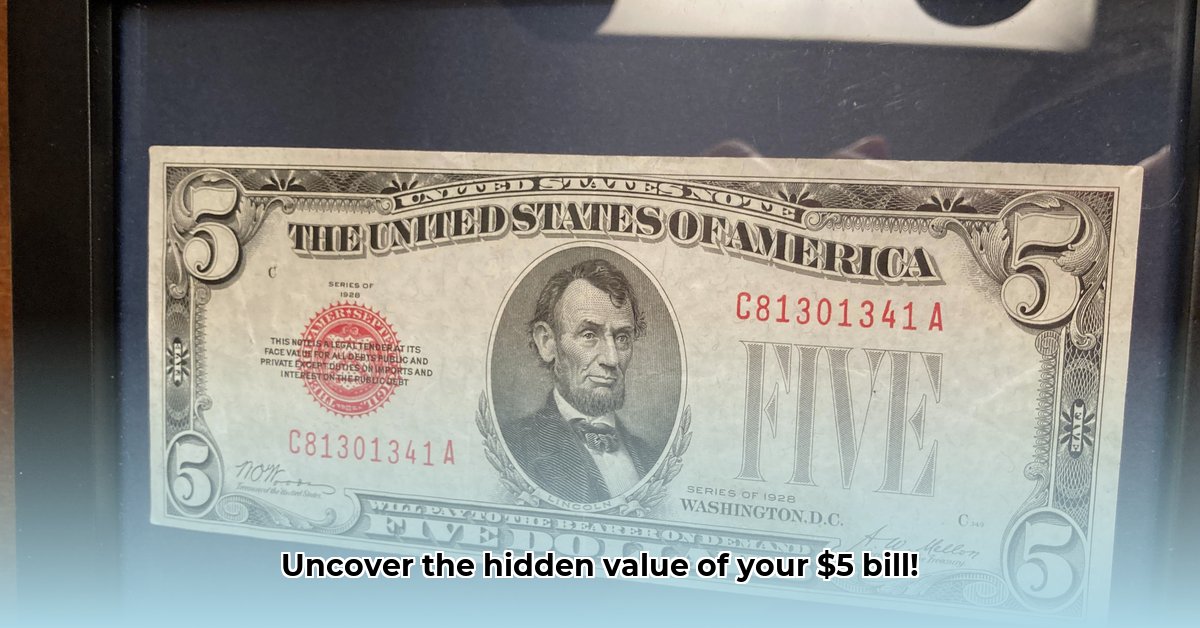
Ever wonder about the true worth of that old five-dollar bill gathering dust in your attic? A 1928 $5 bill could hold surprising value, but determining its precise worth requires careful analysis. This comprehensive guide will equip you with the knowledge to assess your bill's potential, whether you're a seasoned collector or a curious newcomer to the world of numismatics. We'll delve into the key factors influencing value, explore the market, and offer practical advice to help you navigate this fascinating field. For more on valuing older currency, check out this guide on older coin values.
Factors Affecting Value: Decoding the Clues
Several factors combine to determine the value of a 1928 $5 bill. Understanding these elements is crucial for accurate valuation. Think of it as a puzzle, where each piece contributes to the complete picture.
Series: A, B, C, or D – Unveiling the Edition
The bill's series (A, B, C, or D) significantly impacts its value. Each series represents a different printing run, with varying levels of rarity. Series A and B are generally more common, while series C and D, particularly star notes (replacement bills issued for printing errors), are considerably rarer and thus more valuable. Rarity is a key driver of collectible value across different markets. Have you ever wondered why a first edition book is worth more than a later reprint? The same principle applies here.
Condition: The Impact of Time and Handling
The condition of the bill is another critical factor. Numismatists use grading systems, most commonly the Sheldon Scale, ranging from Poor (1) to Gem Uncirculated (70). A "Gem Uncirculated" (GEM-68) bill, exhibiting virtually no signs of wear, commands a significantly higher price than a "Good" (GD-4) bill showing considerable wear and tear. The difference is analogous to comparing a perfectly preserved classic car to one left to rust in a junkyard.
Special Features: The Golden Tickets of Numismatics
Certain features can dramatically increase a bill's value. Star notes, already mentioned, are highly sought after. Additionally, bills with "fancy serial numbers" – those with repeating digits, low numbers, or visually appealing patterns – are highly prized by collectors due to their rarity and aesthetic appeal. These special features act as multipliers on the base value determined by series and condition. Imagine the difference in value between a regular baseball card and a rare rookie card – the effect is similar.
Market Overview and Data Analysis: Navigating the Landscape
The market for 1928 $5 bills is dynamic, influenced by supply, demand, and the factors discussed above. Prices vary depending on these factors and can differ between sources. While general trends exist, individual valuations can show significant variation. This characteristic mirrors other collectible markets, such as art and rare stamps, where subjectivity and market forces interplay significantly.
Valuation Strategies: A Step-by-Step Approach
To determine your bill's value, follow these steps:
- Identify the Series: Carefully examine the series letter (A, B, C, or D) printed on the note.
- Assess the Condition: Use the Sheldon Scale or a similar grading system. High-quality photography is essential for accurate assessment.
- Note Special Features: Document the presence of star notes or fancy serial numbers.
- Research Market Data: Consult online resources and price guides, but remember market fluctuations.
- Seek Professional Appraisal (Optional): For high-value bills, consider consulting a professional numismatist for a more definitive valuation. This is especially important when dealing with exceptionally rare or high-value notes.
Risk Assessment and Authentication: Protecting Your Investment
Before purchasing or investing significantly in a 1928 $5 bill, it's crucial to verify its authenticity. Counterfeit bills exist, and damage reduces value. Professional authentication services should be employed to confirm authenticity and condition.
| Feature | Counterfeiting Risk | Damage/Deterioration Risk | Market Volatility Risk |
|---|---|---|---|
| Star Notes | Medium | Medium | Medium |
| Fancy Serial Numbers | High | Medium | High |
| High-Grade Notes | Low | High | Low |
| Standard Notes | Low | Low | Low |
Actionable Advice for Different Stakeholders
- Collectors: Prioritize high-grade, rare notes. Track market trends and diversify your portfolio.
- Dealers: Invest in authentication technology. Establish strong relationships with collectors and appraisers.
- Auction Houses: Specialize in niche areas of numismatics. Offer expert appraisal services to build trust and attract high-value consignments.
Conclusion: The Ongoing Quest for Value
The value of a 1928 $5 bill is a multifaceted puzzle. By understanding the key factors—series, condition, and special features—and utilizing established valuation strategies, you can accurately assess its worth. Remember, the numismatic world is constantly evolving; continuous research and expert consultation contribute to informed decisions in this dynamic field.